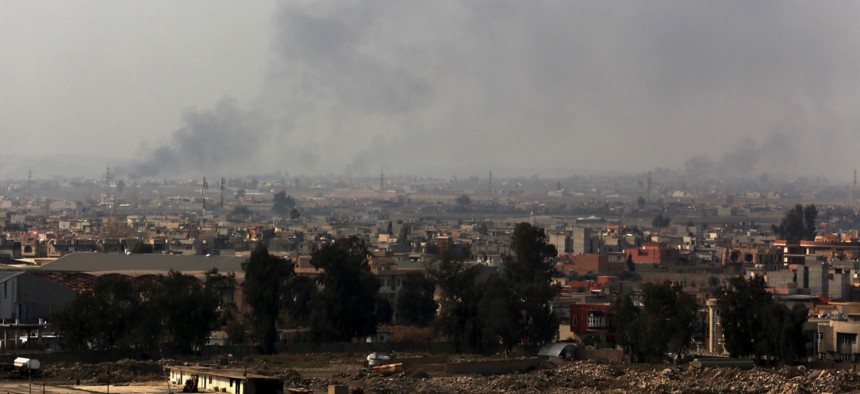
Smoke rises from the western side of Mosul following a U.S.-led coalition airstrike, in Mosul, Iraq, Monday, Jan. 30, 2017. Khalid Mohammed/AP
Take Off the Pentagon’s Gloves in the ISIS War? Not So Fast.
Policies intended to reduce civilian harm didn’t arise out of elite Washington think tanks or academia; they arose from the military’s own lessons learned.
There are worrying signs the United States is about to back away from its role in setting the high bar for reducing civilian casualties in conflict. That would be a horrible mistake.
President Donald Trump consistently has said he believes the U.S. has been hamstrung in the fight against Islamic terrorists by fighting a “politically correct” war. In December of 2015, he famously said, “The other thing with the terrorists is you have to take out their families,” a tactic illegal under international law. On January 28, Trump issued a memorandum asking for a “review of recommended changes to the rules of engagement and other policy restrictions that exceed the requirements of international law regarding the use of force” in the fight against ISIS. This should give advocates for civilian protection and anybody who has an interest in defeating ISIS reason for concern.
U.S. military leaders of the war against ISIS have reportedly hoped the new administration would get the White House and National Security Council out of the day-to-day decisions they felt were hamstringing war operations. Nonetheless, given the high risk that an increase in civilian deaths stemming from U.S. actions will be portrayed by our adversaries as a deliberate expression of the President’s stated intentions, we believe the Pentagon, which will ultimately shoulder the blame and any operational consequences of civilian casualties, should proceed with an abundance of caution. Some options for ramping up the fight against ISIS (and possibly Al Qaeda) may be worth considering. But when it comes to protection for civilians, now is not the time to “take the gloves off” in the fight against terrorists.
The “gloves” in this case are rules and constraints on the use of lethal force by U.S. forces, expressly intended to limit civilian harm, which meet or exceed the requirements of international humanitarian law. These rules were codified at varying thresholds and levels of specificity and clarity by the Obama administration in the Presidential Policy Guidance on direct action against targets outside of Iraq, Syria, and Afghanistan, and the Executive Order on Pre- and Post Strike Measures to Address Civilian Casualties.
We can’t yet know or predict the extent to which the Trump administration intends to depart from Obama’s directives and policies on civilian casualties. Based on the memorandum and his public comments, Trump seems to be betting that, given the choice, the military will return to some lower threshold of self-restraint if released from “political” concerns over civilian harm. The Pentagon should instead take the opportunity to keep existing protections in place, and call the president’s attention to the fact that policies intended to reduce civilian harm didn’t arise out of elite Washington think tanks or academia; they arose from the military’s long-held assessment of their strategic benefits—assessments based on hard-won battlefield experience, as many researchers, including Luke Hartig, former senior director for counterterrorism at the National Security Council under Obama, have pointed out.
Retired Gens. David Petraeus and Stanley McChrystal, as commanders of the Afghanistan War, set a higher standard for avoiding civilian harm than what the Geneva Conventions required. It wasn’t just because it was the right thing to do. Evidence showed that doing so could reduce local support for the Taliban, and over time they figured out ways to do it without compromising their effectiveness or exposing U.S. forces to greater risk of harm.
Of course, no military commander likes to limit their options unnecessarily. It’s likely some of today’s war commanders, troops, operators, agents, and contractors will welcome a review of the rules of engagement to allow them the latitude they feel they need to defeat the enemy. And of course, even with constraints on the use of force, civilian harm will occur. But the fight against al-Qaeda and ISIS is unlikely to get any easier and indeed, may become even more difficult if our message to the Yemenis, Iraqis, Syrians, and Somalis, whose support we need, is suddenly, “You’re not welcome in the United States, and we’re going to relax the rules so we can kill more of your children.”
The Pentagon has no control over the president’s immigration policies, yet it may limit the potential harm to long-term U.S. interests with a careful response to Trump’s Presidential Memorandum. Because “taking off the gloves” at this point could mean taking the protection of civilians—one of our most effective counterterrorism tools—off the table.
NEXT STORY: One Nuclear Step to Settle an Unsettled Age